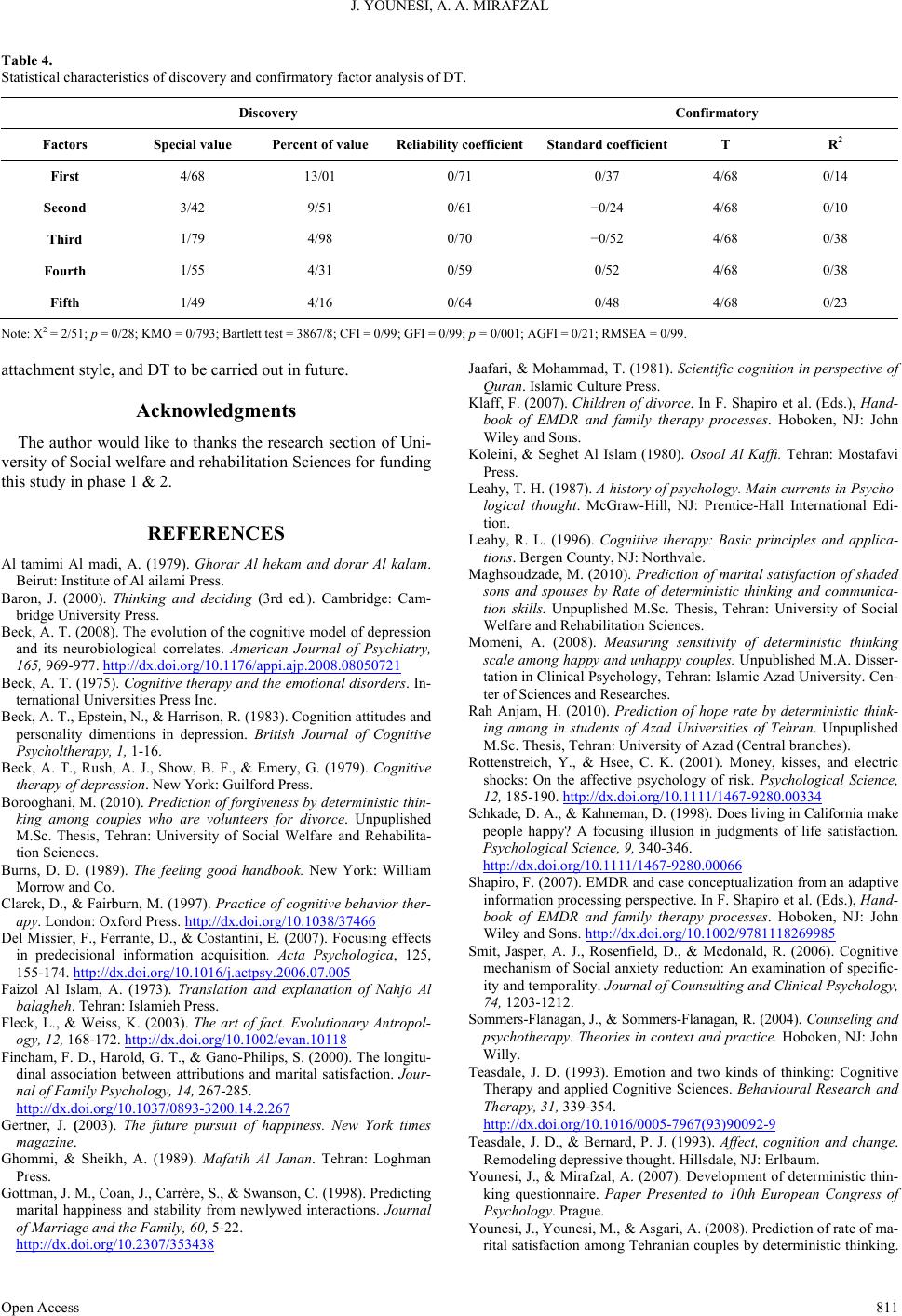
J. YOUNESI, A. A. MIRAFZAL
Open Access 811
Table 4.
Statistical characteristics of discovery and confirmatory factor analysis of DT.
Discovery Confirmatory
Factors Special value Percent of value Reliability coefficientStandard coefficientT R2
First 4/68 13/01 0/71 0/37 4/68 0/14
Second 3/42 9/51 0/61 −0/24 4/68 0/10
Third 1/79 4/98 0/70 −0/52 4/68 0/38
Fourth 1/55 4/31 0/59 0/52 4/68 0/38
Fifth 1/49 4/16 0/64 0/48 4/68 0/23
Note: X2 = 2/51; p = 0/28; KMO = 0/793; Bartlett test = 3867/8; CFI = 0/99; GFI = 0/99; p = 0/001; AGFI = 0/21; RMSEA = 0/99.
attachment style, and DT to be carried out in future.
Acknowledgments
The author would like to thanks the research section of Uni-
versity of Social welfare and rehabilitation Sciences for funding
this study in phase 1 & 2.
REFERENCES
Al tamimi Al madi, A. (1979). Ghorar Al hekam and dorar Al kalam.
Beirut: Institute of Al ailami Press.
Baron, J. (2000). Thinking and deciding (3rd ed.). Cambridge: Cam-
bridge University Press.
Beck, A. T. (2008). The evolution of the cognitive model of depression
and its neurobiological correlates. American Journal of Psychiatry,
165, 969-977. http://dx.doi.org/10.1176/appi.ajp.2008.08050721
Beck, A. T. (1975). Cognitive therapy and the emotional disorders. In-
ternational Universities Press Inc.
Beck, A. T., Epstein, N., & Harrison, R. (1983). Cognition attitudes and
personality dimentions in depression. British Journal of Cognitive
Psycholtherapy, 1, 1-16.
Beck, A. T., Rush, A. J., Show, B. F., & Emery, G. (1979). Cognitive
therapy of depression. New York: Guilford Press.
Borooghani, M. (2010). Prediction of forgiveness by deterministic thin-
king among couples who are volunteers for divorce. Unpuplished
M.Sc. Thesis, Tehran: University of Social Welfare and Rehabilita-
tion Sciences.
Burns, D. D. (1989). The feeling good handbook. New York: William
Morrow and Co.
Clarck, D., & Fairburn, M. (1997). Practice of cognitive behavior ther-
apy. London: Oxford Press. http://dx.doi.org/10.1038/37466
Del Missier, F., Ferrante, D., & Costantini, E. (2007). Focusing effects
in predecisional information acquisition. Acta Psychologica, 125,
155-174. http://dx.doi.org/10.1016/j.actpsy.2006.07.005
Faizol Al Islam, A. (1973). Translation and explanation of Nahjo Al
balagheh. Tehran: Islamieh Press.
Fleck, L., & Weiss, K. (2003). The art of fact. Evolutionary Antropol-
ogy, 12, 168-172. http://dx.doi.org/10.1002/evan.10118
Fincham, F. D., Harold, G. T., & Gano-Philips, S. (2000). The longitu-
dinal association between attributions and marital satisfaction. Jour-
nal of Family Psychology, 14, 267-285.
http://dx.doi.org/10.1037/0893-3200.14.2.267
Gertner, J. (2003). The future pursuit of happiness. New York times
magazine.
Ghommi, & Sheikh, A. (1989). Mafatih Al Janan. Tehran: Loghman
Press.
Gottman, J. M., Coan, J., Carrère, S., & Swanson, C. (1998). Predicting
marital happiness and stability from newlywed interactions. Journal
of Marriage and the Family, 60, 5-22.
http://dx.doi.org/10.2307/353438
Jaafari, & Mohammad, T. (1981). Scientific cognition in perspective of
Quran. Islamic Culture Press.
Klaff, F. (2007). Children of divorce. In F. Shapiro et al. (Eds.), Hand-
book of EMDR and family therapy processes. Hoboken, NJ: John
Wiley and Sons.
Koleini, & Seghet Al Islam (1980). Osool Al Kaffi. Tehran: Mostafavi
Press.
Leahy, T. H. (1987). A history of psychology. Main currents in Psycho-
logical thought. McGraw-Hill, NJ: Prentice-Hall International Edi-
tion.
Leahy, R. L. (1996). Cognitive therapy: Basic principles and applica-
tions. Bergen County, NJ: Northvale.
Maghsoudzade, M. (2010). Prediction of marital satisfaction of shaded
sons and spouses by Rate of deterministic thinking and communica-
tion skills. Unpuplished M.Sc. Thesis, Tehran: University of Social
Welfare and Rehabilitation Sciences.
Momeni, A. (2008). Measuring sensitivity of deterministic thinking
scale among happy and unhappy couples. Unpublished M.A. Disser-
tation in Clinical Psychology, Tehran: Islamic Azad University. Cen-
ter of Sciences and Researches.
Rah Anjam, H. (2010). Prediction of hope rate by deterministic think-
ing among in students of Azad Universities of Tehran. Unpuplished
M.Sc. Thesis, Tehran: University of Azad (Central branches).
Rottenstreich, Y., & Hsee, C. K. (2001). Money, kisses, and electric
shocks: On the affective psychology of risk. Psychological Science,
12, 185-190. http://dx.doi.org/10.1111/1467-9280.00334
Schkade, D. A., & Kahneman, D. (1998). Does living in California make
people happy? A focusing illusion in judgments of life satisfaction.
Psychological Science, 9, 340-346.
http://dx.doi.org/10.1111/1467-9280.00066
Shapiro, F. (2007). EMDR and case conceptualization from an adaptive
information processing perspective. In F. Shapiro et al. (Eds.), Hand-
book of EMDR and family therapy processes. Hoboken, NJ: John
Wiley and Sons. http://dx.doi.org/10.1002/9781118269985
Smit, Jasper, A. J., Rosenfield, D., & Mcdonald, R. (2006). Cognitive
mechanism of Social anxiety reduction: An examination of specific-
ity and temporality. Journal of Counsulting and Clinical Psychology,
74, 1203-1212.
Sommers-Flanagan, J., & Sommers-Flanagan, R. (2004). Counseling and
psychotherapy. Theories in context and practice. Hoboken, NJ: John
Willy.
Teasdale, J. D. (1993). Emotion and two kinds of thinking: Cognitive
Therapy and applied Cognitive Sciences. Behavioural Research and
Therapy, 31, 339-354.
http://dx.doi.org/10.1016/0005-7967(93)90092-9
Teasdale, J. D., & Bernard, P. J. (1993). Affect, cognition and change.
Remodeling depressive thought. Hillsdale, NJ: Erlbaum.
Younesi, J., & Mirafzal, A. (2007). Development of deterministic thin-
king questionnaire. Paper Presented to 10th European Congress of
Psychology. Prague.
Younesi, J., Younesi, M., & Asgari, A. (2008). Prediction of rate of ma-
rital satisfaction among Tehranian couples by deterministic thinking.